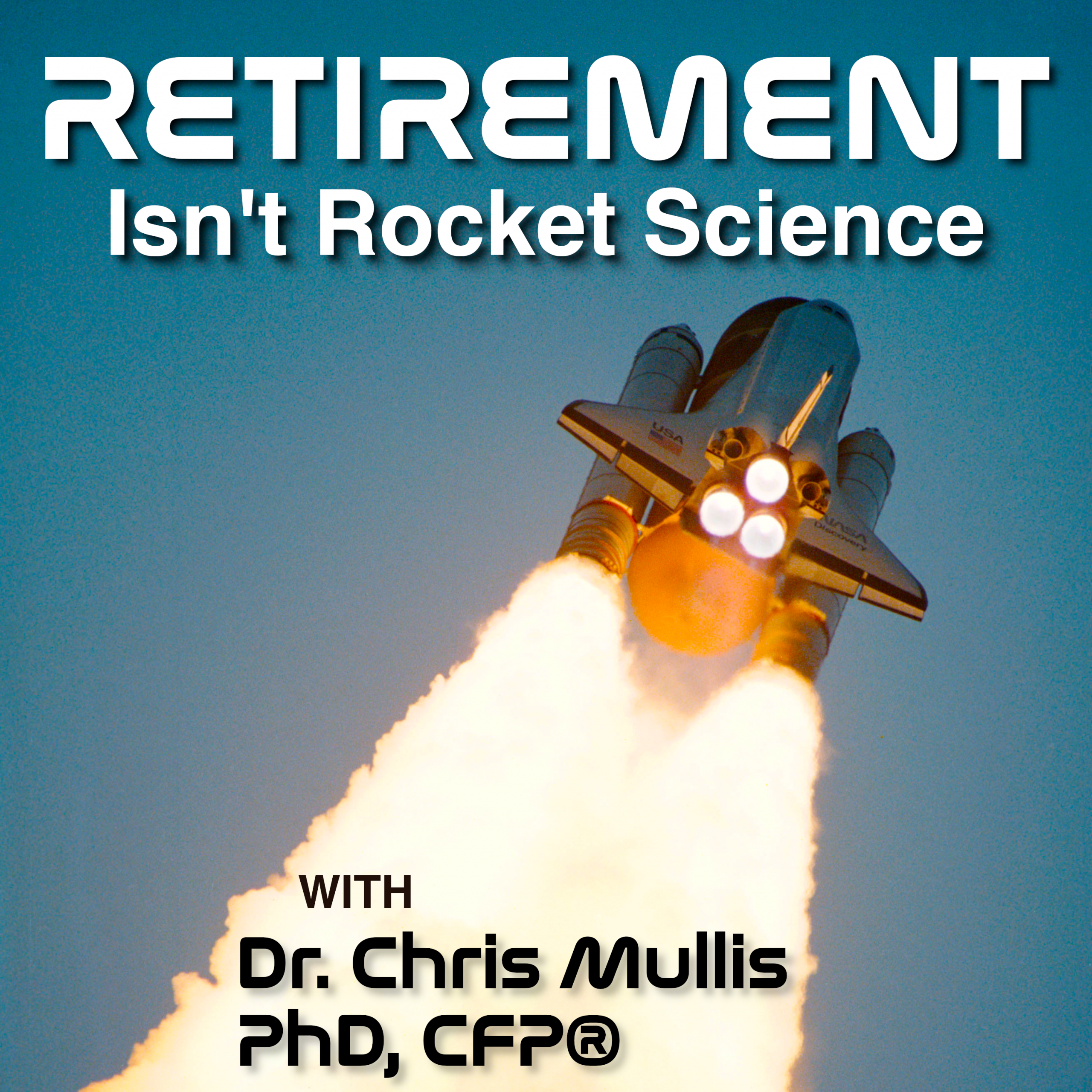Purpose Doesn’t Retire When You Do!

Tired of hearing that retirement is just one long vacation? On this episode, we dive into a powerful idea: that a fulfilling retirement requires more than just a hefty nest egg; it’s about purpose. Dr. Chris breaks down the often-overlooked emotional side of this major life transition and shows you how to design a meaningful “third act” that’s just as dynamic as your career.
The Big Picture
IRAS 04302, aka “The Butterfly Star” is an active planet-forming system. The central protostar is surrounded by a nebula that looks like a butterfly, with its wings fanning out and a brown stripe down the center resembling its body. This “butterfly” is actually a thick disk of gas and dust from which planets are forming.


Sign Up for The Launch
The Launch is a weekly email from Dr. Chris and his team. It’s full of retirement tips, news, listener questions & more, straight from us to your inbox. Get smarter about retirement in just 5 minutes every week. Let’s go!
Episode Resources
- Creating A Great Later Life: Purpose Doesn’t Have To Retire
By Erika Anderson
Episode Transcript
Introduction
Creating your fulfilling third act, navigating the nuanced emotions of retirement and catching a glimpse of the beautiful butterfly star. Are you ready?
Welcome to Retirement Isn’t Rocket Science. I’m your host, Dr. Chris Mullis. For the past 20 years, I’ve been helping people just like you, design and carry out amazing retirement missions. Now, let’s admit with the changes in various moving parts of retirement, it can seem a little daunting, especially when you’re first starting out.
I can assure you retirement is not an unsolved mystery of the universe, and it’s most certainly not rocket science, but just in case things do get a little hard from a technical or complexity perspective, I have a background in rocket science, so we’re gonna be ready no matter what comes our way.
In this week’s show, we examined the often overlooked emotional and psychological aspects of retirement. Perhaps like many of us, you’ve been so focused on reaching your financial goals. You haven’t given much thought to what’s next. We’ll tackle how to craft a purposeful retirement because your purpose doesn’t retire just because you do. And in our listener question segment, we’ll think through the emotional side. Are you truly ready to make the leap to retirement in your head?
Finally in the big picture part of our show, we zoom out the visit the butterfly star, a beautiful birthplace of star and planetary formation. Now let’s dive in.
Retirement Briefing Room
Welcome to the Retirement Briefing Room. This is where we huddle up to take a close look at retirement related research and news articles, and think about how to integrate these into your plans to make your retirement even better.
This week we’re diving into a thought provoking article from Forbes entitled, creating a Great Later Life Purpose Doesn’t Have To Retire. It’s written by Erica Anderson and draws on her experience retiring from a company that she built. Erica provides a step-by-step guide to help people create a fulfilling third act of life.
Erica argues that while retirement is often presented as an endless vacation. It can also lead to a loss of identity and an increase in depression, especially for those who strongly identify with their professional lives.
She outlines a practical process for envisioning a purposeful and joyful later life. She emphasizes that you don’t have to be a visionary to do this. Every person. Has the capacity to imagine a hopeful future, which is key to actually achieving it.
Now let’s dive into three key takeaways from this article. Number one, retirement isn’t just about finances, it’s about purpose. We’ve spent our entire careers getting to this point, working hard, making a good income, saving wisely, investing for the long run.
But this article reminds us of a crucial truth. While you’ve worked hard to build a substantial nest egg, and I commend you for that, the emotional and psychological transition can be just as complex.
Erica points out that many people, especially those who identified strongly with their professional roles, can struggle with a loss of identity after they stop working. I often see this when I’m helping clients. While they’re in great financial shape, they still feel a bit lost without the routine and purpose of work.
This is why a holistic approach is so important. It’s not just about managing your wealth, it’s about managing your life.
An action item in this domain is to be prepared to talk about more than just your money, be it talking to yourself with self-talk, or with your life partner or with your financial advisor. Think about what you’d like your day-to-day life to look like in retirement. And if you’re already retired, think about how you can make your day-to-day life even better. A second. Key takeaway is to envision your future by looking inward, not just forward. This article gives us a great framework for crafting a vision for your later life, and it starts with the question, what are you solving for? This isn’t just about setting some generic goal, it’s about getting to the heart of what’s important to you.
For example, your question might be, how can I create a purposeful later life? From there, the author suggests a practical two-part exercise. First, get clear on where you are now. That’s your strengths, your relationships, and your assets. Then identify the negative things that might make it harder for you to reach your goal.
When I’m working on the financial part of a retirement plan, I do something similar. I analyze my client’s financial situation, their investments, their income, their insurance, their taxes. Their estate plans, and then we pinpoint any gaps. By applying the same logic to your personal life, you can create what the author calls a reasonable aspiration.
That is a vision that is both hopeful and realistic.
An action item to strongly consider in this domain is to write down your, what am I solving for question for retirement.
Then list a few personal assets, like great health or a strong social network, and then write down a few gaps.
For example, maybe you, been so busy with work, you haven’t cultivated any hobbies or invested in any relationships outside of work
the third key takeaway of this article is your imagination is a powerful tool for planning. Now for the fun part, the article encourages us to use our imagination. Erica says that every human being has the ability to envision a future that doesn’t exist yet. She outlines a simple process For this first, select a timeframe in the future. For example, I’m in my early seventies. Then imagine yourself there and describe what you see and what you feel. For example, I’m living a purposeful life mentoring young people and spending time on my passion projects. This isn’t just like a daydream, it’s a strategic exercise. When you can clearly picture your future, you can begin to make more intentional decisions in the present. This ties directly into what I do as a financial planner. I use your financial data to create models for your retirement, showing you what different strategies could look like years down the road.
Remember, as our author Erica Anderson says, purpose doesn’t retire by thinking about more than just your money. You can truly craft a retirement that is not only secure, but also purposeful, joyful, and deeply satisfying.
We thank Erica for this Thoughtful Retirement article. If you’re interested in learning more, there’s a link to the Forbes article in today’s show notes that you’ll find that retirement isn’t rocket science.com/one. Again, that’s retirement isn’t rocket science.com/one
now let’s head over to mission Control to answer your financial and retirement questions.
Ask Mission Control
In this week’s Ask Mission Control. We have a question from one of our listeners that’s more about the heart than the wallet. The question is how do I know if I’m emotionally ready to retire? This is a fantastic and important question because retirement isn’t just a financial event, it’s a major life transition.
Think of it like a rocket launch. You can have all the fuel and the technical specs perfect for the space flight. That’s your financial plan. But if the astronaut crew isn’t mentally prepared for the journey, things could get bumpy. Emotional readiness is about having a clear vision for what you’re retiring to, not just what you’re retiring from.
For many of us, our careers have been our identity, our daily routine, and our social circle for decades. So when that’s gone, what fills the void?
To figure out if you’re ready, ask yourself a few key questions. First, have you thought about your daily routine when the alarm clock goes off and you don’t have a job to go to, what’s your plan for the day?
For the week, for the month? For many people, a lack of structure could lead to a feeling of lost or boredom. We’re talking about transitioning from a highly structured career-driven life to a more fluid purpose-driven one
consider your social connections. Will you be losing your primary social outlet when you leave your workplace? Your colleagues are a big part of your daily life. Do you have other friends and family you can spend more time with? Or new hobbies or new groups you can join to build a community?
And finally, what’s your sense of purpose? This is perhaps the most critical part of the emotional launchpad. You have to find a new one
this could be volunteering for a cause. You care deeply about pursuing a long held passion. Starting a small side business or simply being that go-to grandparent, having a new mission helps give your retirement meaning and keeps you feeling engaged and fulfilled.
A real financial advisor will not just optimize your money, they’ll also help you get clear on your dreams, your passions, and what you hope to do with all that time. This is where a holistic approach to planning really pays off. We are here to help you design a life. Not just a spreadsheet.
If you’ve got a retirement question you’d like us to answer on the show, head over to retirement isn’t rocket science.com and click Ask a question.
Or even better, you can skip to the front of the line by calling Mission Control directly at 7 0 4. 2, 3, 4, 6, 5 5 0 and record an audio question. Again, that’s 7 0 4 2 3 4 6 5 5 0.
Retirement Big Picture
Welcome to the Retirement Big Picture part of our show. This is where we look up and look out to expand our appreciation and understanding of our amazing universe. Before I was a certified financial planner and retirement specialist. I spent almost two decades studying the cosmos as an observational astrophysicist.
So this subject is near and dear to my heart. Today’s big picture is I RRA S 0 4 3 0 2, affectionately nickname the Butterfly Star.
This is a mesmerizing, an exciting object in space, located about 525 light years away in the Constellation Taurus. It’s not just a pretty picture. It’s a window into the very process of planet formation. Imagine looking back in time to see our own solar system being born. That’s essentially what we’re doing here.
It was first identified by the infrared astronomical satellite, a joint mission by nasa, the United Kingdom and the Netherlands. In the 1980s, the IRS mission was a groundbreaking endeavor that mapped the entire sky in infrared light, which is crucial for seeing through the thick dust clouds that obscure these types of stellar nurseries.
IRS was the very first professional data I ever looked at in my life. I was 18 years old and doing my senior project at Providence Day School. As part of that senior project, I did an internship at Johns Hopkins University and analyzed I RRA S data
Now back to the butterfly. The beauty of IRS 0 4 3 0 2 lies in its structure, which is a magnificent testament to the chaos and order. Cosmic birth, the object is a proto star, a young star still gathering mass from the surrounding cloud of gas and dust. This material forms a massive dusty disc that we’re viewing from a unique edge on perspective.
This edge on view is key because the thick, dark line of the disc itself blocks the light from the central protostar
This creates two striking glowing lobes above and below the disc, like the wings of a butterfly. Which are actually reflection nebulae illuminated by the light from the star bouncing off the surrounding dust.
You’ll find the most recent web space telescope image of the Butterfly Star in today’s show. Notes at retirement Isn’t rocket science.com/one?
Be sure to check it out.
Conclusion
Hey, that’s all we have this week. For the links to today’s retirement article and that beautiful image of the butterfly star head over to retirement isn’t rocket science.com/one. Thank you so much for joining me.
Until next time, I’m Dr. Chris reminding you your retirement isn’t rocket science, but yours can be as exciting as a moonshot, so aim high and plan well.
Credits
We thank the National Aeronautics and Space Administration for providing the radio communications between the space shuttle astronauts and the flight controllers. This show is for informational and entertainment purposes only.
Disclaimer
It is not specific tax, legal or investment advice. Before considering acting on anything you’ve heard in the show, first consult your own tax, legal or financial advisor.


